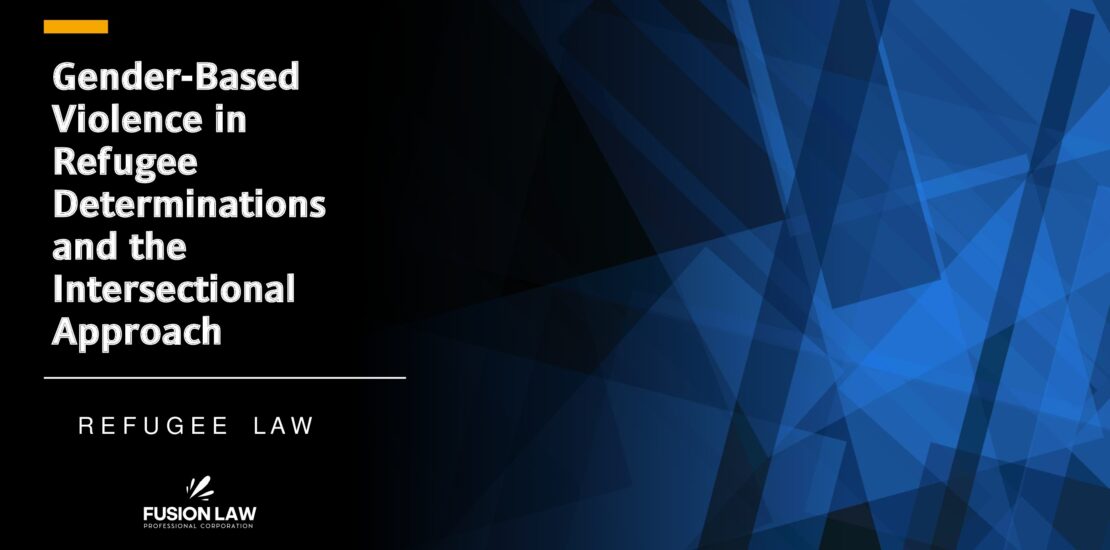𝗚𝗲𝗻𝗱𝗲𝗿-𝗕𝗮𝘀𝗲𝗱 𝗩𝗶𝗼𝗹𝗲𝗻𝗰𝗲 𝗶𝗻 𝗥𝗲𝗳𝘂𝗴𝗲𝗲 𝗗𝗲𝘁𝗲𝗿𝗺𝗶𝗻𝗮𝘁𝗶𝗼𝗻𝘀 𝗮𝗻𝗱 𝘁𝗵𝗲 𝗜𝗻𝘁𝗲𝗿𝘀𝗲𝗰𝘁𝗶𝗼𝗻𝗮𝗹 𝗔𝗽𝗽𝗿𝗼𝗮𝗰𝗵
- November 27, 2024
- Posted by: Fusion Law
- Categories: Immigration, Refugee Appeal

The Gender Guidelines for refugee claimants have been expanded to include individuals of all genders and gender identities. While this broader framework addresses gender-based violence, gender inequality, and discrimination, it also acknowledges the disproportionate impact these issues have on women, girls, and individuals with diverse SOGIESC (sexual orientation, gender identity and expression, and sex characteristics). These factors are recognized as human rights violations that require specific attention in the refugee determination process.
Intersectionality is an analytical framework for understanding how multiple identity factors, such as gender, disability, race, religion, indigenous status, age, and sexual orientation, interact to produce distinct and compounded forms of discrimination, marginalization, and mistreatment. The application of intersectional analysis has become a vital tool in policy and adjudicative contexts, ensuring a holistic approach to complex social realities.
An intersectional approach emphasizes the importance of understanding the historical, social, and political contexts of a claimant’s experiences. It acknowledges that an individual’s identity is shaped by the interaction of various personal factors.
A refugee claimant is considered a convention refugee under section 96 of the IRPA where they face “more than a mere possibility” of persecution if they return to their country of nationality. A claimant must demonstrate on a balance of probabilities that they have both a subjective fear and that there is an objective basis for that fear.
The Federal Court of Canada has underscored the significance of an intersectional analysis in refugee claims, particularly where complex identity factors are involved. For instance, in the case of a female Roma victim of intimate partner violence (Djubok v. Canada (Citizenship and Immigration), 2014 FC 497 the Court highlighted the necessity of assessing the claim through an intersectional lens. Similarly, in Gorzsas v. Canada (Citizenship and Immigration), 2009 FC 458 the Court found that the intersectionality of the claimant’s sexual orientation and health status as an HIV-positive gay male Roma necessitated a thorough risk assessment.
The Federal Court has also found that a Pre-Removal Risk Assessment (PRRA) officer failed to conduct a cumulative and intersectional risk assessment regarding an applicant who alleged a risk of persecution or harm in El Salvador due to his profile as a returnee with severe mental illness being deported due to serious criminality (Rodriguez Ramos v. Canada (Citizenship and Immigration), 2022 FC 41
In the case of Bhuiyan v. Canada (MCI), 2024 FC 1359, the applicant had been living in the United States without status for over 25 years. After experiencing escalating violence from her husband, which culminated in an incident where she was physically assaulted and expelled from their home, she fled to Canada and claimed refugee status, fearing that returning to Bangladesh would put her life at risk.
The Refugee Appeal Division (RAD) rejected her refugee claim, determining that she had not credibly established a risk of persecution or provided an objective basis for her fears. The applicant sought judicial review of the decision, claiming errors in the assessment of her case. The central issue was the RAD’s failure to properly evaluate the credibility of her evidence and to apply the Gender Guidelines effectively.
The Federal Court identified three key errors in the RAD’s credibility analysis:
- 𝗙𝗮𝗶𝗹𝘂𝗿𝗲 𝘁𝗼 𝗖𝗼𝗻𝘀𝗶𝗱𝗲𝗿 𝘁𝗵𝗲 𝗧𝗼𝘁𝗮𝗹𝗶𝘁𝘆 𝗼𝗳 𝗘𝘃𝗶𝗱𝗲𝗻𝗰𝗲: The RAD did not adequately assess the full spectrum of the applicant’s evidence regarding her subjective fear of persecution, particularly her fears from her husband and his political connections.
- 𝗙𝗮𝗶𝗹𝘂𝗿𝗲 𝘁𝗼 𝗔𝗻𝗮𝗹𝘆𝘇𝗲 𝗙𝘂𝘁𝘂𝗿𝗲 𝗥𝗶𝘀𝗸: The RAD did not sufficiently analyze the potential future risk of persecution the applicant faced upon returning to Bangladesh.
- 𝗙𝗮𝗶𝗹𝘂𝗿𝗲 𝘁𝗼 𝗔𝗽𝗽𝗹𝘆 𝗚𝗲𝗻𝗱𝗲𝗿 𝗚𝘂𝗶𝗱𝗲𝗹𝗶𝗻𝗲𝘀: Although the RAD made an attempt to apply the Gender Guidelines, the Court found this effort to be inadequate. The Court outlined several key areas where the RAD had not properly applied these guidelines, such as:
- Understanding power dynamics in the refugee hearing process.
- Adopting a trauma-informed approach during cross-examination.
- Appropriately addressing inconsistencies in the applicant’s testimony about gender-based violence.
- Avoiding myths and stereotypes related to gender violence.
While decision-makers are required to probe internal inconsistencies in a witness’ evidence and as well as inconsistencies in the evidence as between witnesses, they should approach the explanations provided from a trauma-informed perspective. In this case, the Court found that the RAD set the bar too high in expecting a woman with limited education to be able to explain the complexities of the impact of gender violence on her son. The Court recognized that it may take bystanders of domestic violence years to unpack their own trauma in order to recognize what they did and did not see.
The Federal Court granted the applicant’s application for judicial review, ruling that the RAD’s decision was flawed. The case was referred back to be redetermined by a different decision-maker, who must properly consider the applicant’s evidence and apply the Gender Guidelines in a more thorough and informed manner.
The Federal Court’s decision underscores the importance of a comprehensive and sensitive approach in refugee hearings, especially in cases involving gender-based violence. The Court emphasized that the Gender Guidelines must be applied rigorously to avoid biases and ensure that the applicant’s testimony is assessed with due consideration of the complex dynamics of abuse and trauma.
𝘕𝘰𝘵𝘦: 𝘛𝘩𝘪𝘴 𝘤𝘰𝘯𝘵𝘦𝘯𝘵 𝘱𝘳𝘰𝘷𝘪𝘥𝘦𝘴 𝘢 𝘨𝘦𝘯𝘦𝘳𝘢𝘭 𝘰𝘷𝘦𝘳𝘷𝘪𝘦𝘸 𝘰𝘧 𝘵𝘩𝘦 𝘴𝘶𝘣𝘫𝘦𝘤𝘵 𝘮𝘢𝘵𝘵𝘦𝘳. 𝘍𝘰𝘳 𝘴𝘱𝘦𝘤𝘪𝘧𝘪𝘤 𝘭𝘦𝘨𝘢𝘭 𝘢𝘥𝘷𝘪𝘤𝘦, 𝘪𝘵 𝘪𝘴 𝘳𝘦𝘤𝘰𝘮𝘮𝘦𝘯𝘥𝘦𝘥 𝘵𝘩𝘢𝘵 𝘺𝘰𝘶 𝘤𝘰𝘯𝘴𝘶𝘭𝘵 𝘸𝘪𝘵𝘩 𝘢𝘯 𝘢𝘵𝘵𝘰𝘳𝘯𝘦𝘺 𝘳𝘦𝘨𝘢𝘳𝘥𝘪𝘯𝘨 𝘺𝘰𝘶𝘳 𝘪𝘯𝘥𝘪𝘷𝘪𝘥𝘶𝘢𝘭 𝘤𝘪𝘳𝘤𝘶𝘮𝘴𝘵𝘢𝘯𝘤𝘦𝘴.



